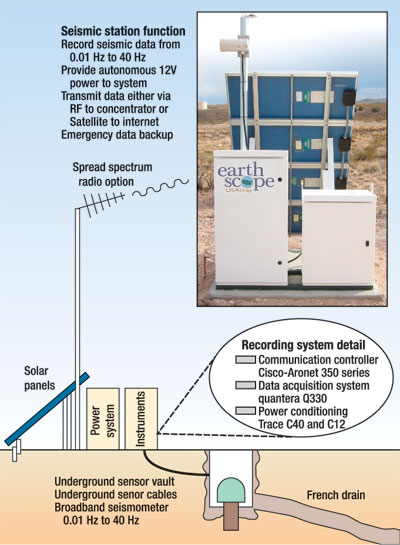What's new in exploration
What is EarthScope? It is one of the most ambitious geoscience projects ever conceived. It is a multi-disciplinary observing system designed to measure how the North American continent is deforming in response to ongoing plate-tectonic forces. It requires leading-edge technology in observational, analytical and telecommunication to investigate the structure and evolution of the North American continent and processes controlling mountain building, earthquakes and volcanic eruptions. EarthScope will provide a foundation for fundamental and applied research that will contribute to mitigation of risks from geological hazards, development of natural resources and understanding of Earth dynamics. EarthScope can be thought of as an inverted telescope designed to image with unprecedented detail, the distribution of rock properties of the lithopshere and deeper Earth. EarthScope is composed of four main components.
This should yield a detailed image of the internal structure of North America and the underlying mantle. It should also enable mapping surface changes before, during and after major earthquakes and volcanic eruptions. A 2.5-mi deep observatory, bored directly into the San Andreas fault, will explore conditions that control earthquake triggers and fault rupture on the continent’s most active fault system. Here are three good links for more detailed information and images: www.earthscope.org; www.agiweb.org/geotimes/april02/index.html; and dax.geo.arizona.edu/earthscope. EarthScope is classified as a Major Research Equipment (MRE) initiative of the National Science Foundation (NSF). In the usual parlance of bureaucracy, the MRE of the NSF will have "deliverables," which include enabling: predictions of future earthquakes and cost-mitigation; discernment of imminent volcanic eruption from normal volcanic "breathing"; assessment and development of mineral, petroleum and general water resources; an understanding of how continental landmasses are assembled over geologic time; and future tectonic changes. The project has already passed all of the requisite committees, reviews and many other hurdles that a project of this magnitude must pass, even achieving priority status. More than 50 universities, research institutions and federal agencies have already participated in detailed planning. At least five hundred organizations across the nation would be involved in the operation and analysis, and all data from EarthScope would be openly available, in real-time, to maximize participation from the scientific community and to provide ongoing educational opportunities for students at all grade levels. EarthScope is supported by the Seismological Society of America, the Geological Society of America, the Association of American State Geologists, and the American Geological Institute. These umbrella organizations and societies represent over 100,000 geoscientists. This bold pursuit of "inner space" can be likened to Man’s quest to walk on the Moon, and, like that endeavor, this one also has its critics. Although President Bush requested $35 million for first-year funding of the five-year, $185-million project in his budget proposal to Congress, its funding is precarious at best. Personally, I doubt that many of the deliverables mentioned above would be fully realized by the project. The purported reasons for going to the Moon had nothing to do with the real reasons, namely, Styrofoam beer coolers, satellite-guided bombs – albeit to the wrong embassy address – and a deal LBJ got for a friend on some land south of Houston. Actor Robert Duval has said, "I love the smell of napalm in the morning." Well, this editor loves the smell of WD-40 after oiling his creaky chair. And without the space program, we might not have any of these things – and much more. Exploration of inner space is every bit as worthy as the exploration of outer space. That’s why I support this research. Not for the deliverables that we can predict. But for those we can not.
|
- Prices and governmental policies combine to stymie Canadian upstream growth (February 2024)
- U.S. producing gas wells increase despite low prices (February 2024)
- U.S. drilling: More of the same expected (February 2024)
- U.S. oil and natural gas production hits record highs (February 2024)
- Quantum computing and subsurface prediction (January 2024)
- U.S. upstream muddles along, with an eye toward 2024 (September 2023)
- Applying ultra-deep LWD resistivity technology successfully in a SAGD operation (May 2019)
- Adoption of wireless intelligent completions advances (May 2019)
- Majors double down as takeaway crunch eases (April 2019)
- What’s new in well logging and formation evaluation (April 2019)
- Qualification of a 20,000-psi subsea BOP: A collaborative approach (February 2019)
- ConocoPhillips’ Greg Leveille sees rapid trajectory of technical advancement continuing (February 2019)




